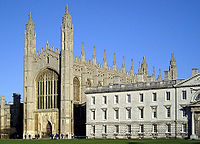Tudor architecture: Difference between revisions
RjwilmsiBot (talk | contribs) m →Domestic buildings: Fix cite template param names, editorfirst -> editor-first, editorlast -> editor-last, using AWB (7701) |
Mszajewski (talk | contribs) No edit summary |
||
| Line 57: | Line 57: | ||
{{Reflist}} |
{{Reflist}} |
||
*{{1911}} |
*{{1911}} |
||
==Further Reading== |
|||
* Garner, Thomas and Arthur James Stratton, [http://libx.bsu.edu/cdm4/collection.php?CISOROOT=/CroqArchJou ''Domestic Architecture of England during the Tudor Period'']. London: B.T. Batsford, 1908-1911. |
|||
==External links== |
==External links== |
||
Revision as of 20:06, 1 September 2011

The Tudor architectural style is the final development of medieval architecture during the Tudor period (1485–1603) and even beyond, for conservative college patrons. It followed the Perpendicular style and, although superseded by Elizabethan architecture in domestic building of any pretensions to fashion, the Tudor style still retained its hold on English taste, portions of the additions to the various colleges of Oxford and Cambridge being still carried out in the Tudor style which overlaps with the first stirrings of the Gothic Revival.
The four-centred arch, now known as the Tudor arch, was a defining feature; some of the most remarkable oriel windows belong to this period; the mouldings are more spread out and the foliage becomes more naturalistic. Nevertheless, "Tudor style" is an awkward style-designation, with its implied suggestions of continuity through the period of the Tudor dynasty and the misleading impression that there was a style break at the accession of Stuart James I in 1603.
There are also examples of Tudor architecture in Scotland, too, such as King's College, Aberdeen.
Church architecture
In church architecture the principal examples are:
- Henry VII Lady Chapel at Westminster Abbey (1503)
- King's College Chapel, Cambridge
- St. George's Chapel, Windsor Castle
Domestic buildings
During this period the arrival of the chimney stack, and enclosed hearths resulted in the decline of the great hall based around an open hearth which was typical of earlier medieval architecture. Instead, fireplaces could now be placed upstairs and it became possible to have a second storey that ran the whole length of the house[1]. Tudor chimney-pieces were made large and elaborate to draw attention to the owner's adoption of this new technology, and the jetty appeared, as a way to show off the modernity of having a complete, full-length upper floor[2].
The style of large houses moved away from the defensive architecture of earlier moated manor houses, and started to be built more for aesthetics. For example, quadrangular, 'H' or 'E' shaped plans became more common[3]. It was also fashionable for these larger buildings to incorporate "devices", or riddles, designed into the building, which served to demonstrate the owner's wit and to delight visitors. Occasionally these were Catholic symbols, for example, subtle or not so subtle references to the trinity, seen in three sided, triangular, or 'Y' shaped plans, designs or motifs[4].
The houses and buildings of ordinary people were typically timber framed, the frame usually filled with wattle and daub but occasionally with brick[2]. These houses were also slower to adopt latest trends and the great hall continued to prevail[1]. The Dissolution of the Monasteries provided surplus land, resulting in a small building boom, as well as a source of stone[2].
Domestic examples
- Eltham Palace, Kent
- Tudor Barn Eltham, Greenwich
- Oxburgh Hall, Norfolk
- Owlpen Manor, Gloucestershire
- King's College, Aberdeen
- Layer Marney Tower, Essex
- East Barsham Manor, Norfolk
- Ford's Hospital, Coventry
- Castle Lodge, Ludlow, Shropshire
- Compton Wynyates
- Hampton Court Palace
- Montacute House (late Tudor)
- Wollaton Hall, Nottinghamshire (late Tudor)
- Old Market Hall, Shrewsbury
- Hunsdon House, Hertfordshire
- Sutton House, London Borough of Hackney
Typical features
Tudor style buildings have six distinctive features -

- Decorative half-timbering
- Steeply pitched roof
- Prominent cross gables
- Tall, narrow doors and windows
- Small window panes
- Large chimneys, often topped with decorative chimney pots
As a modern term
In the 19th century a free mix of these late Gothic elements and Elizabethan were combined for hotels and railway stations, as well as modern residential styles in what is usually referred to as Tudor (or sometimes Mock Tudor styles known as Jacobethan or a more rustic Tudor Revival architecture).
References
- ^ a b Quiney, Anthony (1989). Period Houses, a guide to authentic architectural features. London: George Phillip. ISBN 0540011738.
- ^ a b c Picard, Liza (2003). Elizabeth's London. London: phoenix. ISBN 0753817578.
- ^ Pragnall, Hubert (1984). Styles of English Architecture. Frome: Batsford. ISBN 0713437685.
- ^ Airs, Malcolm (1982). Service, Alastair (ed.). Tudor and Jacobean. The Buildings of Britain. London: Barrie and Jenkins. ISBN 0091478308.
- This article incorporates text from a publication now in the public domain: Chisholm, Hugh, ed. (1911). Encyclopædia Britannica (11th ed.). Cambridge University Press.
{{cite encyclopedia}}: Missing or empty|title=(help)
Further Reading
- Garner, Thomas and Arthur James Stratton, Domestic Architecture of England during the Tudor Period. London: B.T. Batsford, 1908-1911.

